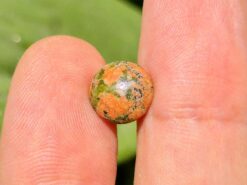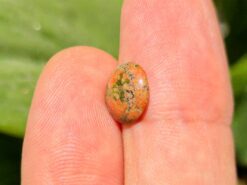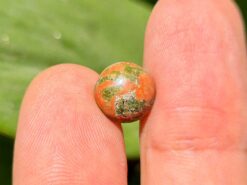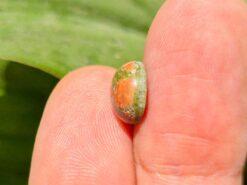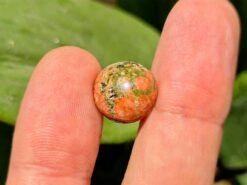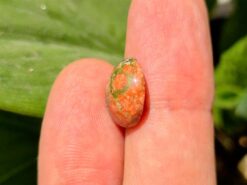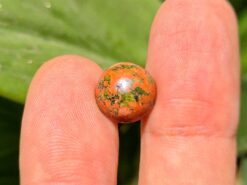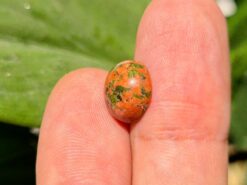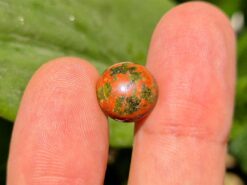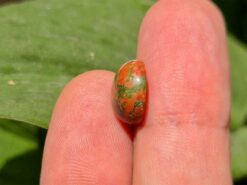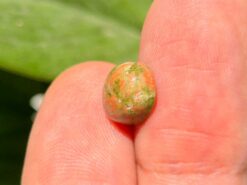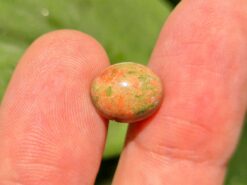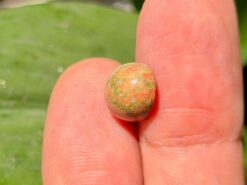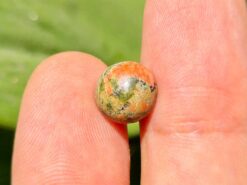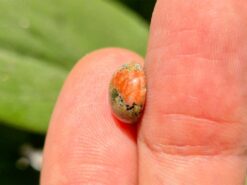Unakite
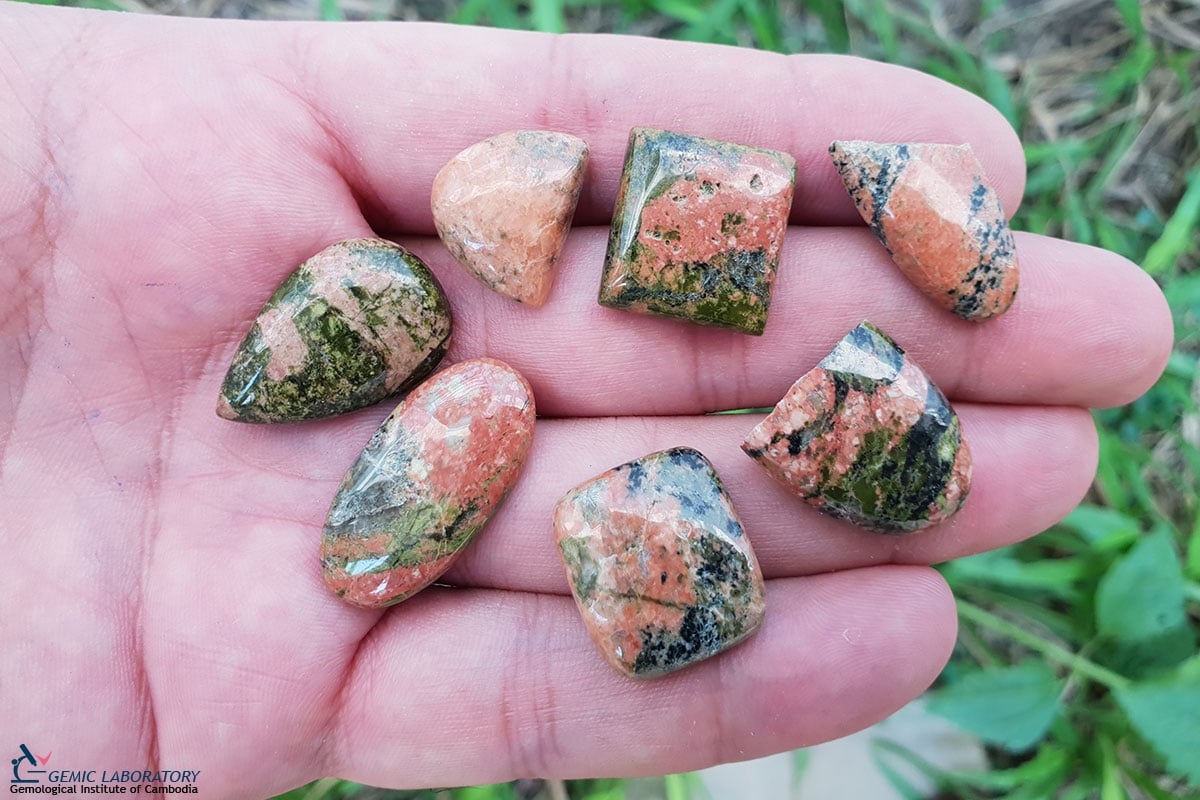
Unakite crystal stone meaning, wrongly named jasper.
Buy natural unakite in our shop
Unakite meaning
Unakite is an intriguing stone known for its distinctive blend of pink and green hues, forming a mottled pattern that captures both the eye and the imagination. Although sometimes mistakenly referred to as a type of jasper, unakite is actually an altered granite composed primarily of pink orthoclase feldspar, green epidote, and generally colorless quartz. The interplay of these minerals creates a uniquely balanced appearance that often evokes the harmonious patterns found in natural landscapes.
Discovered originally in the Unakas mountains of North Carolina, the stone takes its name from this region. The presence of orthoclase and epidote gives unakite its signature palette: warm, pinkish tones contrasted against verdant green. This coloration is not merely cosmetic but is tied to the stone’s geological journey and the intense, metamorphic conditions it endures deep within the Earth’s crust. Over time, fluids rich in iron and other elements infiltrate the rock’s original feldspars, converting them into epidote and enhancing the stone’s striking appearance.
Unakite is regarded as a semiprecious stone that polishes well, making it popular for a wide range of lapidary projects, including beads, cabochons, and ornamental carvings. Its patterns often evoke scenic landscapes or abstract artwork, ensuring that each piece of unakite jewelry or decorative object is one-of-a-kind. Unlike stones that exhibit uniform colors or patterns, unakite’s variegated composition allows artisans to capture natural beauty in a tangible form.
Unakite composition and geological background
While often misunderstood due to its common misidentification as a type of jasper, unakite is a variety of altered granite. Its components—pink orthoclase feldspar, green epidote, and quartz—meld together under specific geologic conditions. Orthoclase feldspar, known for its relatively straight cleavage planes, provides the pink tones. Green epidote, a calcium aluminium iron sorosilicate mineral, results from the hydrothermal alteration of feldspars. Quartz, one of the most abundant minerals in the Earth’s crust, contributes clarity and stability to the stone’s structure.
The process by which unakite forms involves the infiltration of mineral-rich fluids into granite. Over millennia, these fluids alter the original feldspar crystals, converting them into epidote. This metamorphic transformation results in the characteristic green and pink patterning that makes unakite so recognizable. In some localities within the Blue Ridge geological formations, foliation and banding patterns can be observed, reflecting the stone’s complex geological history. These foliated varieties can exhibit subtle linear patterns, further enhancing their visual interest.
When the feldspar is not present, the material is more accurately referred to as epidosite. Such varieties may still share some visual similarities but differ in composition, lacking the subtle pink that orthoclase feldspar imparts. Nevertheless, both unakite and epidosite are valued by lapidaries and collectors for their distinctive patterns and relative ease of shaping and polishing.
Unakite sources
Unakite is found in several regions worldwide, reflecting the global geological processes that give rise to altered granitic formations. It occurs as pebbles and cobbles in glacial drift and can often be collected along the shores of Lake Superior, where wave action and erosion have rounded and polished the stones. In addition, unakite is known to appear in various river valleys of Virginia and is carried downstream from its original outcrops in the Blue Ridge Mountains. Beyond the United States, deposits are located in South Africa, Sierra Leone, Brazil, and China, allowing for a steady supply of this distinctive stone to gem markets around the globe.
While the finest unakite specimens often display a pleasing balance of pink and green hues, some sources produce material with more subtle coloration. Regardless of origin, the stone’s intrinsic charm lies in its nuanced interplay of minerals. Unakite continues to inspire gem enthusiasts, artists, and collectors who appreciate the stone’s unique fusion of natural elements.
Orthoclase, epidote, and quartz
Orthoclase, a potassium feldspar, forms in igneous rocks and lends its pinkish hue to unakite. Its name derives from the Greek words for “straight fracture,” reflecting its cleavage planes that intersect at right angles. Orthoclase plays a significant role in many geological processes and contributes to the structural integrity and coloration of unakite.
Epidote, a calcium aluminium iron sorosilicate mineral, is responsible for the rich green coloration of unakite. Epidote commonly forms through the metamorphic alteration of plagioclase feldspar. Its presence not only influences the stone’s color but also its metaphysical interpretations among crystal enthusiasts.
Quartz, composed of silicon and oxygen, is one of Earth’s most abundant minerals. Present as generally colorless or whitish grains, quartz lends a stable, durable framework that allows unakite to hold up well against everyday wear. The presence of quartz within unakite also facilitates a lustrous finish when polished, making the stone suitable for jewelry and decorative uses.
Unakite meaning and healing properties benefits
The following section is pseudo-scientific and based on cultural beliefs.
Among those interested in crystal healing, unakite is often regarded as a stone of vision. Believers suggest that it can assist in opening the third eye, making it a useful tool for meditation, visualization, and scrying. Its combination of earthy green and gentle pink is said to promote a sense of balance, harmonizing emotions with spirituality and grounding the self in the present moment.
In addition, some practitioners associate unakite with physical and emotional recovery. They claim the stone supports convalescence after illness, helping to restore vitality and foster resilience. While these benefits lack scientific backing, the cultural and personal significance attributed to unakite endures, contributing to its popularity among collectors, healers, and spiritual seekers alike.
Historical and cultural use of unakite
Beyond crystal healing practices, unakite has seen occasional use as an ornamental or decorative stone. Its unique coloration and ability to take a high polish have led to its incorporation into beads, cabochons, and larger carved objects, such as sculptures or home décor items. In certain architectural contexts, unakite’s warm tones and natural patterns have been used in inlays or accents, adding visual intrigue to interiors and crafted artworks.
Over time, unakite has gained recognition not only among mineral collectors but also within jewelry-making communities. Artisans often fashion it into necklaces, bracelets, and rings, capitalizing on its natural patterns to create one-of-a-kind pieces. While it may not be as historically renowned as certain other ornamental stones, unakite’s subtle charm and adaptability have carved out a niche for it in the modern gem and jewelry world.
Working with unakite: Jewelry and lapidary
Lapidaries and jewelers find unakite relatively manageable to cut and shape. Its composition allows for smooth cabochon cutting, and the resulting stones often feature soft, blended swirls of color. Bead makers appreciate unakite’s ability to produce uniform, polished spheres that retain the stone’s signature pink-and-green mottling.
Unakite’s durability, while not as high as some harder gemstones, is sufficient for everyday jewelry if treated with care. When properly set and protected, unakite can serve as a meaningful and lasting addition to any personal collection. Whether showcased in a delicate pendant or used as a highlight in a more elaborate piece, unakite provides a natural elegance that balances vibrant color with subtle complexity.
FAQ
What is unakite good for?
Unakite is said to support convalescence and recovery from illness, according to some crystal healing beliefs. It is also believed to encourage emotional balance and spiritual growth, while promoting feelings of groundedness and harmonious energy.
Where do you put unakite crystal?
Many practitioners suggest placing unakite near growing plants, as its green and pink hues resonate with the natural vitality of flora. Others prefer to keep it in meditation spaces, on altars, or near windows where it can absorb natural light, enhancing the peaceful environment it is said to create.
How do you identify unakite stone?
Unakite is characterized by its distinctive blend of pink orthoclase feldspar and green epidote, often with quartz inclusions. The mottled pattern of pink and green is quite unique, and once you learn to recognize it, you can easily identify unakite in future encounters.
How do you clean unakite?
Warm, soapy water and a soft cloth are generally sufficient for cleaning unakite. Avoid using harsh chemicals or abrasive cleaners. Removing unakite jewelry before engaging in vigorous activities, swimming, or handling chemicals will help preserve the stone’s natural beauty.
What is unakite jasper made of?
Despite the common misnomer “unakite jasper,” it is not a jasper. Unakite is actually altered granite composed of pink orthoclase feldspar, green epidote, and generally colorless quartz. This unique composition differentiates it from jaspers, which are typically forms of microcrystalline quartz.
Is unakite intrusive or extrusive?
Unakite is formed from intrusive igneous rocks. Granite, the host rock from which unakite develops, crystallizes slowly underground, allowing large mineral grains to form. Over time, hydrothermal processes alter the granite, producing unakite’s distinctive colors and patterns.
Natural unakite for sale in our gem shop
We make custom made unakite jewelry such as engagement rings, necklaces, stud earrings, bracelets, and pendants. Each piece highlights the stone’s harmonious colors and patterns. Please contact us for a quote and explore the many ways unakite can enhance your personal collection.

